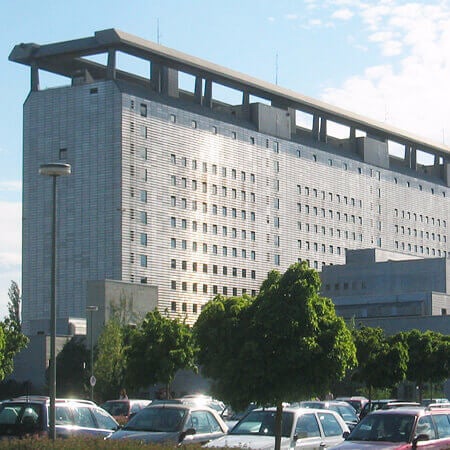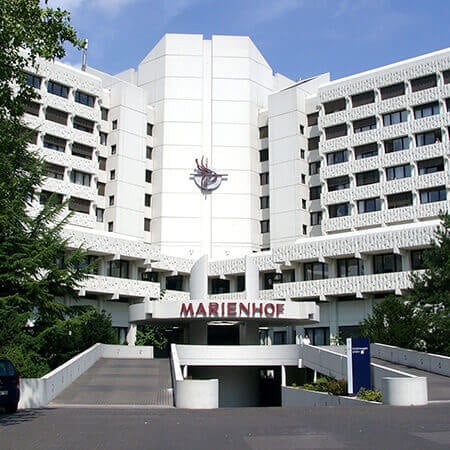Otosclerosis
Otosclerosis is a disease peculiar with the pathological growth of the bone tissues in the middle ear. It leads to the deterioration of bilateral hearing and in some cases – to its complete loss. Otosclerosis is common and found in 1% of the population. Incidence of the disorder is higher in women than in men and reaches 3-4% of the female population.
The Booking Health portal presents 56 German clinics specializing in otosclerosis treatment
Show all clinics
Otosclerosis – Diagnostics
Laboratory methods are not applied in the diagnostics of otosclerosis. The following instrumental methods help the doctor to confirm a diagnosis:
- Tone threshold audiometry
- Impedance audiometry
- Tympanometry
- Radiography
- Computed tomography of the temporal bone
Otosclerosis – Treatment
The purpose of treatment is to slow down the progression of otosclerosis and restore the sound transmission. Surgical intervention is preferable here.
There are several types of surgery aimed to restore the hearing, but the majority of them help to improve hearing only temporarily. That’s why an intervention called stapedoplasty is the most common in the treatment of the disease, as it offers a chance for a long-term improvement.
- Stapedoplasty is the removal of the sclerotic altered stirrup-shaped bone (one of the bones of the middle ear) with its further replacement with the prosthesis. The implant can be artificial – made of ceramics, teflon or titanium. It is also possible to implant a biological prosthesis. It is made from the patient's cartilage or bone tissue.
- Stapedotomy is an improved variant of this surgery. A hole in the basis of the stirrup-shaped bone is made with the help of laser. Afterwards, a piston-type prosthesis is implanted. Such a surgery is more preferable and is actively performed in German hospitals. If you compare the effectiveness of the two interventions, stapedotomy has a much lower risk of postoperative complications.
Other treatment methods are:
- Sodium fluoride is administered to patients to slow down the progression of otosclerosis
- Hearing aids help to improve hearing in patients, who didn’t undergo a timely surgery or refused it
There is a gradual deterioration of hearing during this disease. The prognosis is unfavorable.
The only question is how fast the pathological process will progress:
- 70% of patients have a slow development of the disease
- 20% of patients have an abrupt development of the disease(characterized by long term periods of stability, followed by severe deterioration of hearing)
- 10% of patients have a transient development of the disease (mainly in young patients)
About 80% of cases show a significant improvement in hearing after surgery in the developing countries hospitals. In German clinics, surgical treatment is effective in 90-95% of cases.
The development of complications may occur after surgery. Therefore, it is better to receive treatment in German clinics in order to minimize risks.
Best clinics for the otosclerosis treatment in Germany:

University Hospital of Ludwig Maximilian University of Munich

Catholic Clinic Koblenz-Montabaur

University Hospital Ulm
Otosclerosis – Rehabilitation
Rehabilitation is the process of body restoration from injuries, surgeries or diseases. It can have a different orientation such as: oncological, orthopedic, neurological, etc. There is also general therapeutic rehabilitation. It is indicated for patients after conservative and surgical treatment of the internal organs diseases.
The directions of the general therapeutic rehabilitation
There are several main directions of the therapeutic rehabilitation such as:
- Medical one, which includes the restoration of patient's health, normalization of body functions, stimulation of compensatory possibilities, elimination of the chronic pain, etc.
- Physical one, which is responsible for improving of work capacity and tolerance for physical activities. In the complex cases, the purpose of this therapeutic rehabilitation area may be the restoration of the self-service ability.
- Psychological one, which helps to eliminate the mental disorders which may occur as a result of a disease (phobias, depression, apathy), to increase the human motivation, and to adapt to the changed living conditions.
The World Health Organization underlines 3 phases of rehabilitation such as: hospital phase, a phase of recovery and supporting phase. Different tasks are solved in different phases. The hospital phase is conducted immediately after the treatment. After the first phase begins the second one which usually takes place in sanatoriums or rehabilitation centers. This is the boundary between two periods, namely illness and future life. Then a supporting phase is required. The patient maintains the achieved level of his health and physical activity at home or visits the rehabilitation center from time to time.
Therapeutic rehabilitation methods
The most modern rehabilitation programs are used in Germany. They are adapted individually for each patient, and are based on the recent disease, age, physical possibilities, and the results of treatment. Different specialists such as: therapists, psychologists, rehabilitators, kinesiotherapists, physiotherapists are involved in the rehabilitation process.
The following methods of rehabilitation are used:
- Dosed physical activity
- Training on the simulators and in the pool
- Physiotherapy
- Acupuncture
- Manual therapy
- Microcurrent therapy
- Compression therapy
- Lymphatic drainage
- Natural factors of the nature (mud, thermal waters, etc.)
Any rehabilitation may include medicamentous support. It is necessary to hold a consultation with the patient about the proper nutrition and the way of life which is important for him in the current situation.
Rehabilitation programs in Germany are designed for 2 weeks. If necessary, they can last much longer. In this country, the patient is provided with qualitative care, accommodation in comfortable rooms and individually selected meals.
Rehabilitation programs in Germany show one of the best results in the world. Most patients successfully restore their employability and excellent health there. They remain physically active, return to the full social and family life.
Best clinics for general therapeutic rehabilitation in Germany:
Author:
The article was edited by medical expert, board certified Dr. Nadezhda Ivanisova. For the treatment of the conditions referred to in the article you must consult a doctor; the information in the article is not intended for self-medication!
Source:
The cost of services includes
Here you can find the cost of treatment for this disease at the German University Hospitals. Leave a request and we will provide a free consultation with a doctor and will start organizing the whole treatment process.
The program includes the following:
- Issuing of an invitation for getting a visa for treatment as quick as possible
- Fixing an appointment at a time convenient for you
- Preliminary organization of a comprehensive examination and discussion of the forthcoming treatment plan
- Arranging transfer from the airport to the hospital and back to the airport
- Provision of interpreting services and services of a personal medical coordinator
- If necessary, assistance in the organization of further surgical treatment
- Provision of a medical insurance against treatment complications covering up to 200,000 euro
- Preparation and translation of medical records and recommendations from the hospital
- Assistance in the subsequent communication with your attending physician, including consultations on repeated X-ray images through the unique medical document management system E-doc


